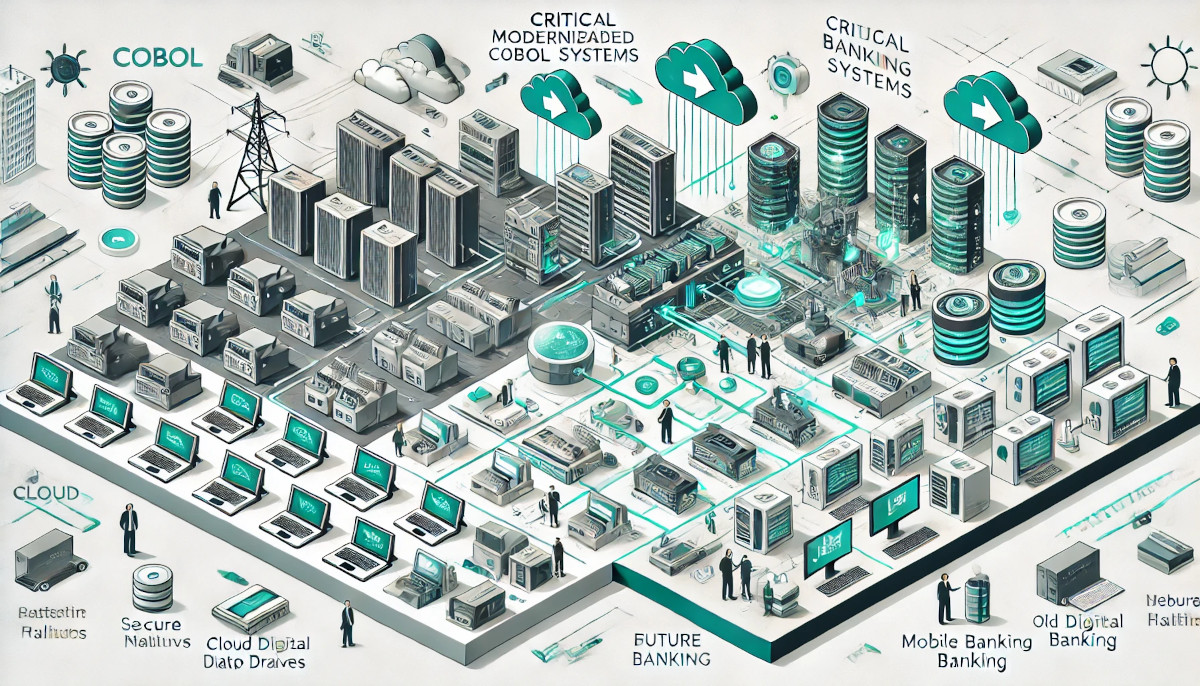
Legacy Tech Meets Modern Banking
For decades, COBOL has been the invisible backbone of banking infrastructure. Today, more than 220 billion lines of COBOL code power global financial systems, from transaction processing to core banking operations. Yet, these systems—once a pillar of resilience—are now barriers to innovation. Banks must confront this reality as regulatory, operational, and technological demands outpace what COBOL-based environments can handle. Institutions that fail to modernize risk falling behind digitally savvy competitors, missing compliance deadlines, and accumulating unsustainable technical debt.
Why Banks Still Rely on COBOL
COBOL was built for stability and batch-processing accuracy. That reliability has kept it at the heart of banking operations for over 60 years. Today, COBOL still powers core systems responsible for high-volume tasks such as ATM transactions, mortgage processing, and account management. However, this same rigidity has become its downfall in a world driven by real-time data, mobile banking, and rapid innovation cycles. Legacy systems typically lack modern APIs, struggle to scale elastically, and can’t integrate easily with AI/ML-based systems—severely limiting a bank’s ability to launch new services or improve customer experience.
The Tipping Point: What’s Forcing Change
Banks can no longer afford to treat modernization as optional. Several urgent forces are converging:
- Compliance Pressures: Regulations like FedNow (real-time payments), Basel IV, and PCI DSS 4.0 are incompatible with many COBOL systems, which lack real-time processing and encryption features.
- Security Risks: COBOL systems often lack built-in encryption, auditability, or support for modern security protocols. This opens banks to cyberattacks, ransomware threats, and non-compliance fines that can reach into the millions.
- Talent Crisis: 68% of COBOL developers are expected to retire by 2025. Knowledge of mission-critical code is walking out the door with no one trained to take their place. The result: operational fragility and spiraling costs.
Together, these pressures create a now-or-never moment for transformation.
The Cost of Waiting
Banks spend between $40,000 to $150,000 per year maintaining a single COBOL-based system, excluding hardware and downtime expenses. On average, legacy environments cost 20–25% more to operate than modern platforms. This cost escalates with each passing year due to:
- Rising labor costs to support aging systems
- Increasing licensing and mainframe compute charges (e.g., MIPS)
- Productivity losses due to outdated tooling
Moreover, banks that delay modernization often suffer compliance violations or breaches—costing millions in fines and reputational damage. By 2030, unmodernized COBOL infrastructure could balloon maintenance costs by 3–5x due to compounding risk exposure.
What COBOL Modernization Looks Like Today
Modernization doesn’t have to mean rewriting everything from scratch. Modern banks are choosing phased approaches that blend stability with agility:
- AI-Powered Code Refactoring: Intelligent parsing and transformation of COBOL into Java, C#, or cloud-native formats.
- Mainframe Offloading: Migrating workloads to the cloud to reduce MIPS consumption while maintaining system integrity.
- API Enablement: Creating real-time interfaces that connect legacy systems to digital banking front-ends.
- Parallel Testing Environments: Running both old and new systems simultaneously to ensure zero business disruption.
These strategies allow banks to maintain uptime, improve time-to-market, and reduce long-term costs.
Why AI-Driven Tools Matter
Manual modernization is slow, expensive, and prone to human error. CodeAura’s AI-driven platform automates up to 80% of the COBOL-to-modern code transformation process, accelerating projects that would otherwise take years.
Key advantages include:
- Automated detection of legacy business logic and dependencies
- Refactoring recommendations with version control integration
- Knowledge capture to preserve institutional memory
- Auto-generated documentation and test cases
By reducing human workload and enhancing consistency, AI tools dramatically shorten project timelines while ensuring accuracy and compliance.
CodeAura’s Approach to Banking Modernization
CodeAura merges AI automation with deep industry expertise to offer banks a reliable path to modernization. Our banking-specific approach includes:
- Core Banking Transformation: Modernizing deposit, lending, and payment systems.
- Compliance Enablement: Built-in support for FedNow, PCI DSS 4.0, Basel IV, and GDPR requirements.
- Knowledge Preservation: Extracting undocumented logic from legacy codebases and converting it into reusable components.
- Agile + DevOps Readiness: Supporting CI/CD pipelines, test automation, and cloud-native deployment for long-term agility.
Whether you’re starting with a single application or planning an enterprise-wide transformation, CodeAura delivers modernization that aligns with your compliance mandates, innovation goals, and operational continuity.
The Road to Resilience Starts with COBOL
Modernizing COBOL systems is not just an IT initiative—it’s a strategic necessity. Banks face unprecedented compliance deadlines, customer expectations, and competitive threats. COBOL modernization empowers institutions to reduce operational risk, improve security posture, and unlock innovation at scale.
Let’s Talk About Your Banking Systems — Schedule a modernization session with CodeAura today.

